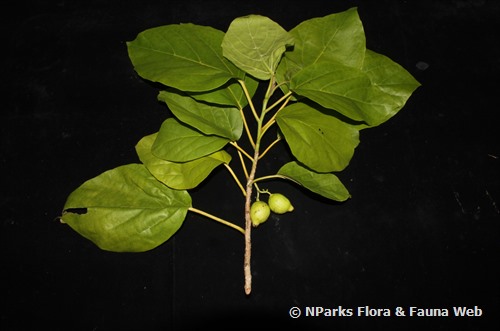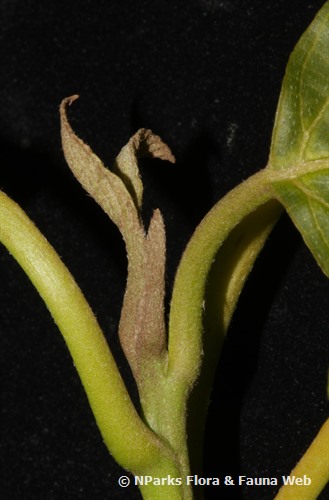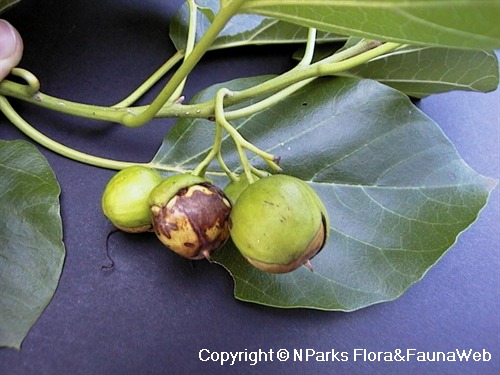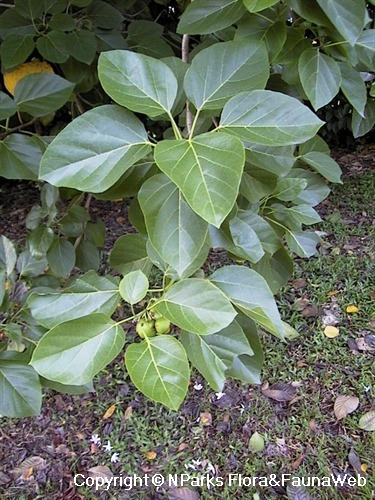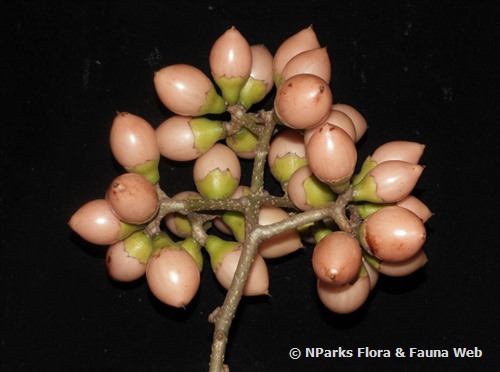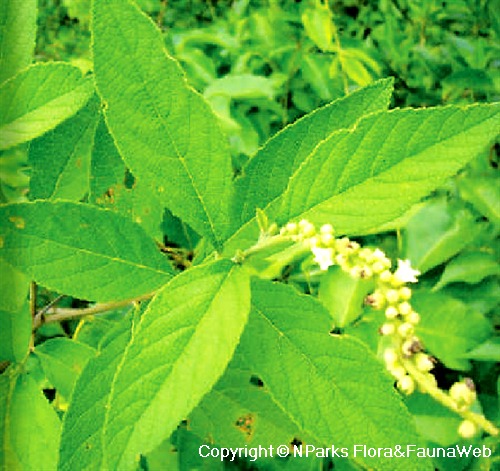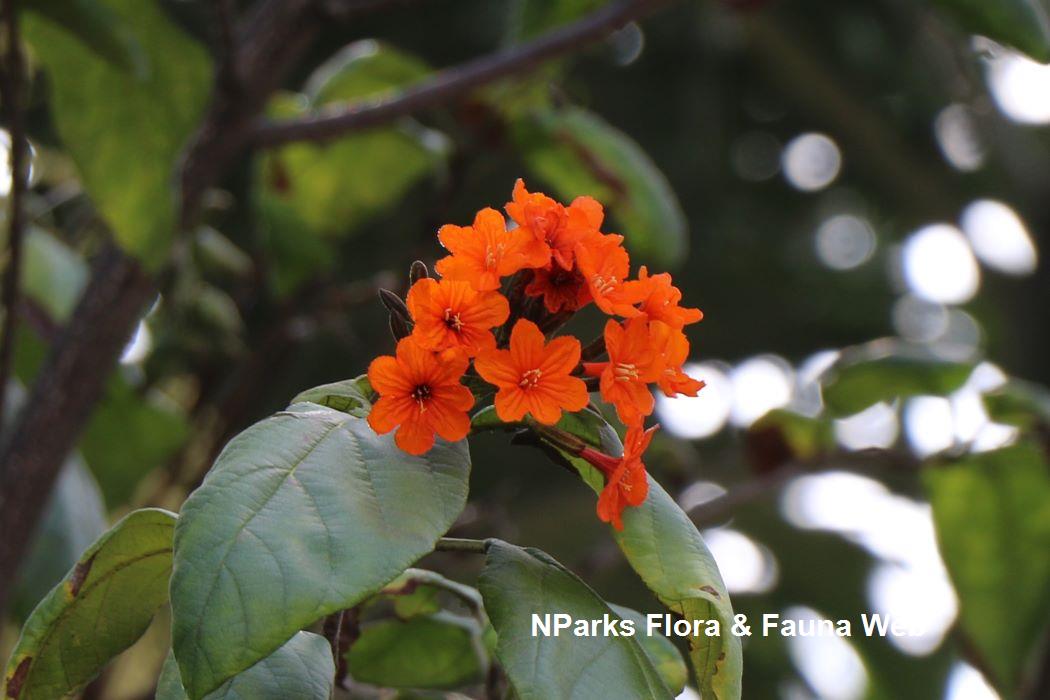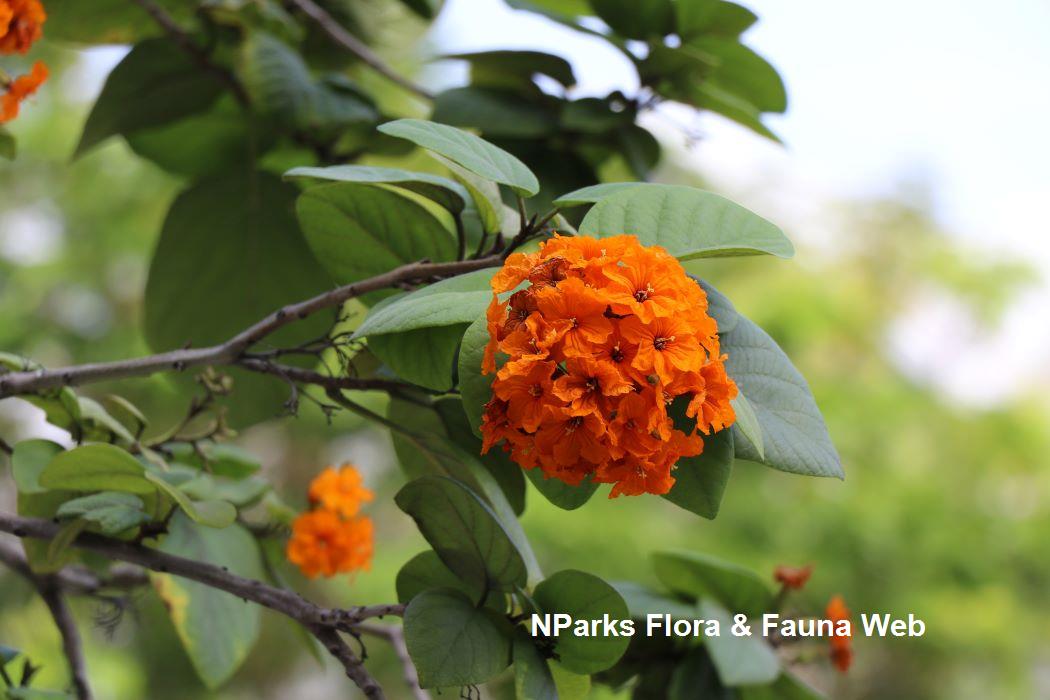
Back
Cordia subcordata Lam.
| Family Name: | Cordiaceae |
| Common Name: | Sea Trumpet, Kerosene Tree, Beach Cordia, Kou |
Name
Classifications and Characteristics
| Plant Division | Angiosperms (Flowering Seed Plants) (Dicotyledon) |
|---|---|
| Plant Growth Form | Tree (Small (6m-15m), Medium (16m-30m)) |
| Maximum Height | 20 m |
Biogeography
| Native Distribution | Coasts of East Africa, India, Indochina, Singapore, Malesia, and islands of the Indian and Pacific Oceans. It occurs locally in some of the Southern Islands. |
|---|---|
| Native Habitat | Terrestrial (Coastal Forest, Primary Rainforest, Secondary Rainforest) |
| Preferred Climate Zone | Tropical |
| Local Conservation Status | Native to Singapore (Critically Endangered (CR)) |
Description and Ethnobotany
| Growth Form | It is a small, evergreen, bushy tree up to 20 m tall. |
|---|---|
| Trunk | Trunk sometimes crooked, girth size is 40 cm wide or less, bark is pale grey and furrowed. |
| Foliage | Light green broadly elliptic to ovate leaves, alternate arrangement, measuring about 8 - 20 cm long and 5 - 15 cm wide, petiole about 5 cm long. |
| Flowers | Orange funnel-shaped flowers borne on axillary and terminal cymose inflorescence, each flower about 2.5 - 4 cm long and has 5 - 7 wrinkly and rounded lobes, peduncle about 0.5 - 2 cm long, pedicels about 2 - 10 mm. |
| Fruit | Fruit is a brown, round and woody nut about 1.5 - 3 cm long, contains 4 or less white seeds. |
| Habitat | Usually found in coastal forests, secondary forest and thickets along the sea shore. |
| Etymology | Genus Cordia is named after Valerius Cordus (1514 - 1544), a German botanist and pharmacist, and considered as one of the fathers of pharmacognostics. Species subcordata means somewhat heart-shaped and refers to the leaves. In Papua New Guinea, the common name "Kerosene Tree" was derived because this tree burns easily. |
| Ethnobotanical Uses | Edible Plant Parts : Edible Seeds Timber & Products: The wood is used to make furniture, paddles, drums and artifacts. Agriculture - Forestry: The leaves can be used as fodder for livestock. Cut - Dried Flower: In Hawaiian culture, the flowers are used to make a garland called lei. Cultural / Religious: The wood is used to make figures and groves and they are planted along sacred places. |
Landscaping Features
| Desirable Plant Features | Ornamental Flowers |
|---|---|
| Landscape Uses | Parks & Gardens, Small Gardens |
Fauna, Pollination and Dispersal
| Fauna Pollination Dispersal Associated Fauna | Caterpillar Moth Food Plant |
|---|
Plant Care and Propagation
| Light Preference | Full Sun |
|---|---|
| Water Preference | Moderate Water |
| Plant Growth Rate | Moderate |
| Rootzone Tolerance | Moist Soils, Well-Drained Soils |
| Propagation Method | Seed |
Foliar
| Foliage Retention | Evergreen |
|---|---|
| Mature Foliage Colour(s) | Green |
| Leaf Area Index (LAI) for Green Plot Ratio | 3.0 (Tree - Intermediate Canopy) |
Floral (Angiosperm)
| Flower Colour(s) | Yellow / Golden |
|---|
Fruit, Seed and Spore
| Mature Fruit Colour(s) | Brown |
|---|
Image Repository
Others
| Master ID | 1533 |
|---|---|
| Species ID | 2826 |
| Flora Disclaimer | The information in this website has been compiled from reliable sources, such as reference works on medicinal plants. It is not a substitute for medical advice or treatment and NParks does not purport to provide any medical advice. Readers should always consult his/her physician before using or consuming a plant for medicinal purposes. |

